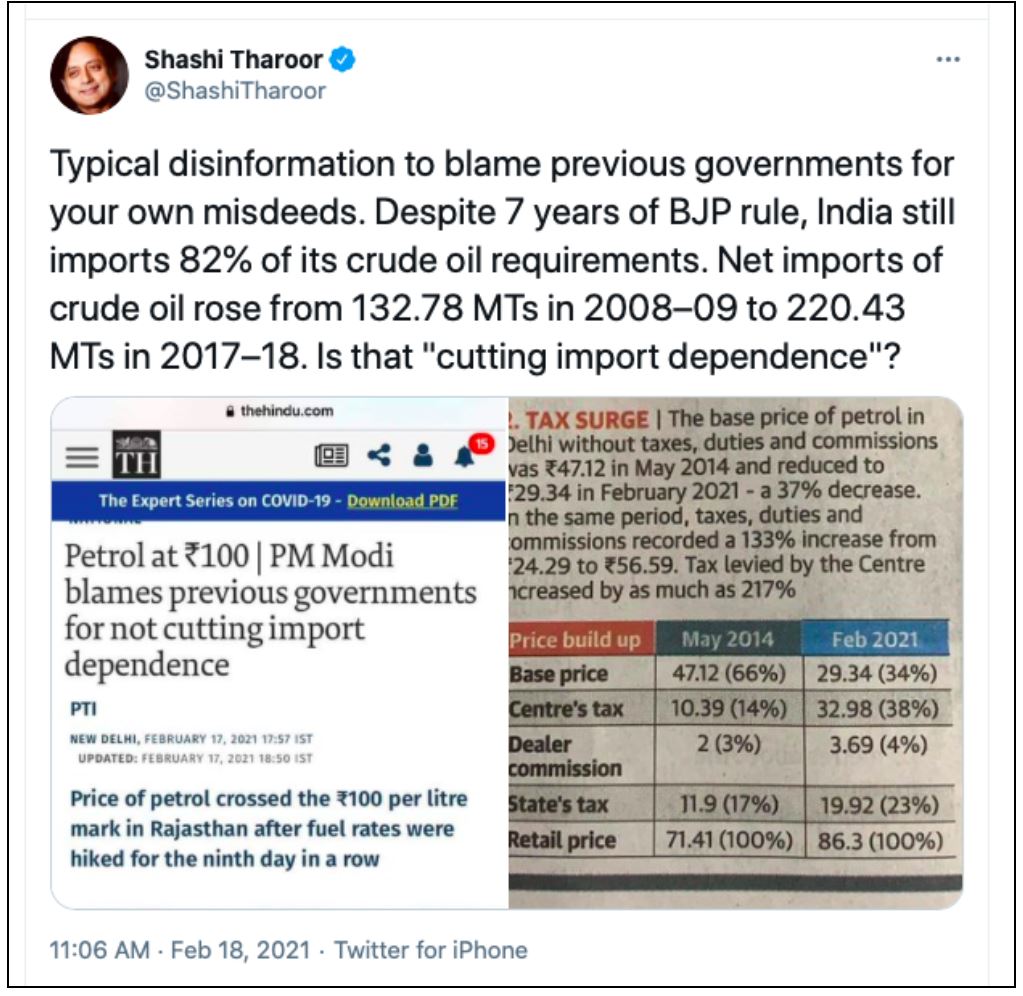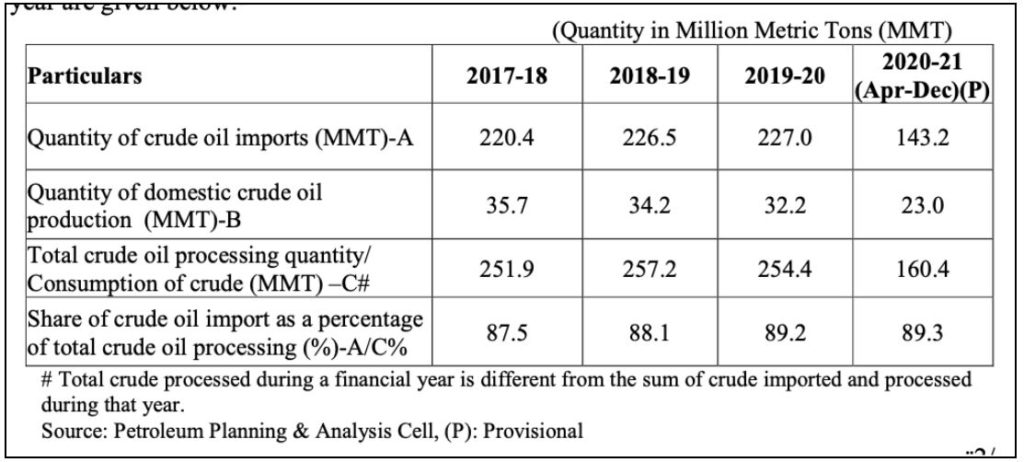The PM recently spoke about India’s dependence on crude oil imports. Data indicates that the share of crude oil imported to meet domestic demand has increased steadily in the last few years and crossed 89% in 2019-20. On the other hand, domestic production has steadily decreased during the same period.
Addressing a recent online event, Prime Minister Narendra Modi stated that if the previous governments had focused on reducing India’s energy import dependence, the Indian middle-class would have been less burdened. This statement comes on the backdrop of rising fuel prices in the country with the price of petrol closing in on Rs. 100 in a few of the states. He further remarked that India imported over 85% of its oil needs & 53% of its gas requirement in 2019-20, highlighting India’s energy import dependence.
Later, Dr. Shashi Tharoor, INC’s MP from Thiruvananthapuram, referred to the statement by the PM in his tweet and pointed out that in spite of the 7-year rule of the BJP, India still imports 82% of its crude oil requirements.

In the tweet, he further highlighted that the increase in net import of crude oil, wherein it was 132.78 MTs in 2008-09 and increased to 220.43 MTs in 2017-18.
Information provided by the government indicates an increasing reliance in import of Crude Oil
The information provided by the Union government indicates an increase in the share of Crude oil imports corresponding to the crude oil requirements. Responding to a question in the Lok Sabha on 08 February 2020, the Union Minister for Petroleum and Natural Gas provided the details of – Crude oil imports, domestic production, and Crude oil processed/consumed in the country.

As per this information, the ‘Total crude oil processing quantity (consumption of Crude)’ in 2017-18 was 251.9 MMT (Million Metric Tonnes), of which crude oil imports were 220.4 MMT i.e., 87.5% of the total processed crude oil.
In the subsequent two years of 2018-19 & 2019-20, the processing quantity was 252.2 MMT and 254.4 MMT respectively, with a YOY increase in the volume of crude oil imported with 226.5 MMT and 227 MMT. The increase in import volume resulted in an increase in the share of imports out of the total processed quantity to 88.1% and 89.2% respectively. During these three years, there is a gradual decline in domestic crude oil production.
Consistent increase in the country’s Crude oil requirement over the last two decades
As per the information provided by PPAC (Petroleum Planning & Analysis Cell), the crude oil requirement i.e. Crude oil processing quantity for the year 2020-21 as of January’ 2021 was 182 MMT (Million Metric Tonnes).
In the previous year i.e., 2019-20, it was 254 MMT. This was the first time since 1998-99 that the volume of processed crude was less than the previous year. In 2018-19, the volume of processed crude was 257 MMT. This is in continuation of the slow growth rate in the processed crude volume observed in recent years. In fact, during the current regime of NDA since 2014, the highest single-year increase was recorded in 2016-17 when the volume of processed crude increased by 12.5 MMT i.e., an increase of 5.4% over the previous year. Apart from recording the only negative growth for over two decades, the lowest growth in the volume of crude processed was also during the current regime when the increase was a mere 0.36% in 2014-15.
Comparatively, there has been a higher increase in the volume of crude processed during the 10-year UPA rule (i.e., 2004-2014). Even the Consumption of Petroleum Products has displayed a similar trend over the years. In 1998-99, 90.5 MMT of various petroleum products were consumed, which increased to 214 MMT in 2019-20. While there has been a year-on-year increase in the consumption of petroleum products, the growth has slowed down in recent years.
Increase in the share of Crude Oil Imports over the last few years
As per the information provided by PPAC, as of the end of January’2021, India imported 162 MMT of Crude oil. This forms 89.39% of the total Crude oil processed during the same period in 2020-21 i.e., 182 MMT.
The volume of crude oil being imported has increased year on year since 1998-99. For 1998-99, a total of 39.8 MMT of Crude oil was imported by India. During the first year of the UPA regime in 2004-05, India imported 95.8 MMT. By the last year of the regime i.e., during 2013-14, the crude oil imports grew to 189 MMT. This is a growth of 99% in terms of yearly volume during the 10-year period.
While the volume of imports stabilized during 2012-15, there has been a corresponding increase observed since 2015-16. We have already seen that over the years, there has been an increase in both the processing of crude oil as well as the demand for petroleum products. What is significant is that share of imports to meet this growing demand has also increased since domestic production is more or less stagnant. Hence it is not only the volume of crude oil being imported that has increased but its share corresponding to the requirement has also increased.
In 1998-99, imports formed around 58% of the total crude oil requirement of the country and this share witnessed a sharp increase over the ensuing years, peaking at 85.37% during 2009-10. After a fall in the ensuing year, the share of imports only recorded a marginal growth until 2014-15. During 2015-16, the share of imports increased to 87.1%, which by 2019-20 increased to 89.2%. The data does point to an increased dependency on imports to meet the growing crude oil requirement. This increase is more evident from the higher increase in the share in the last recent 3 years compared to only a marginal increase in imports by volume.
No major change in the indigenous production over past two decades
Economic growth has a direct relationship with the consumption of fuel. The increase in the demand for crude oil and the consumption of petroleum products can be attributed to the strong & consistent economic growth of India over the last two decades. However, as the data indicates, the increase in the demand has also seen a corresponding increase in the share of crude imports.
This can be attributed to a small but steady fall in domestic production in recent years. In fact, there has been no major increase in the domestic production of crude oil over the past two decades. During 1998-99, 32.76 MMT of crude oil was produced indigenously. With minor fluctuations in production over the years, the highest production was recorded in 2011-12 with 38.08 MMT. Since then, there has been a decline in domestic production with a steeper decline observed since 2014-15. In 2019-20, the domestic production was 32.17 MMT, which is the lowest in almost 20 years.
Need for result-oriented strategies that can reduce Crude oil-import dependency
Increasing demand for crude-oil & petroleum products is a strong indicator of higher economic activity, which in turn signifies economic growth. Hence, the slow rate of growth in the processing of petroleum as well as consumption of petroleum products can be attributed to the slowdown in economic activity over the past few years.
This could also point towards a reliance on other alternative sources for meeting the fuel demand. However, with the total consumption of petroleum products increasing steadily, the alternate fuel sources have not made much of an impact to meet the demand. As observed from the data, the reliance on crude-oil imports has increased in recent years, corroborated with the data which shows a fall in domestic production.
In the earlier quoted response in Lok Sabha, the Union Minister for Petroleum & Natural Gas highlights the various initiatives of the government to enhance the domestic production of oil & natural gas to reduce the reliance on imports.

However, the trend of decreasing domestic production highlights the gap between the initiatives of the government and reality. While there are efforts to explore and increase the domestic crude oil production, there are questions around the extent of India’s natural oil reserves and if they are sufficient to meet the growing demand of the country.
Hence, investing in alternative fuels alongside petroleum is a path the country is required to take up. The Government highlights these initiatives in the same response in Lok Sabha.

While the Prime Minister’s claim that earlier governments have not focused on reducing the crude oil import dependency is true, data also indicates that there has been no improvement even during the current regime with the share of imports actually increasing than earlier.


